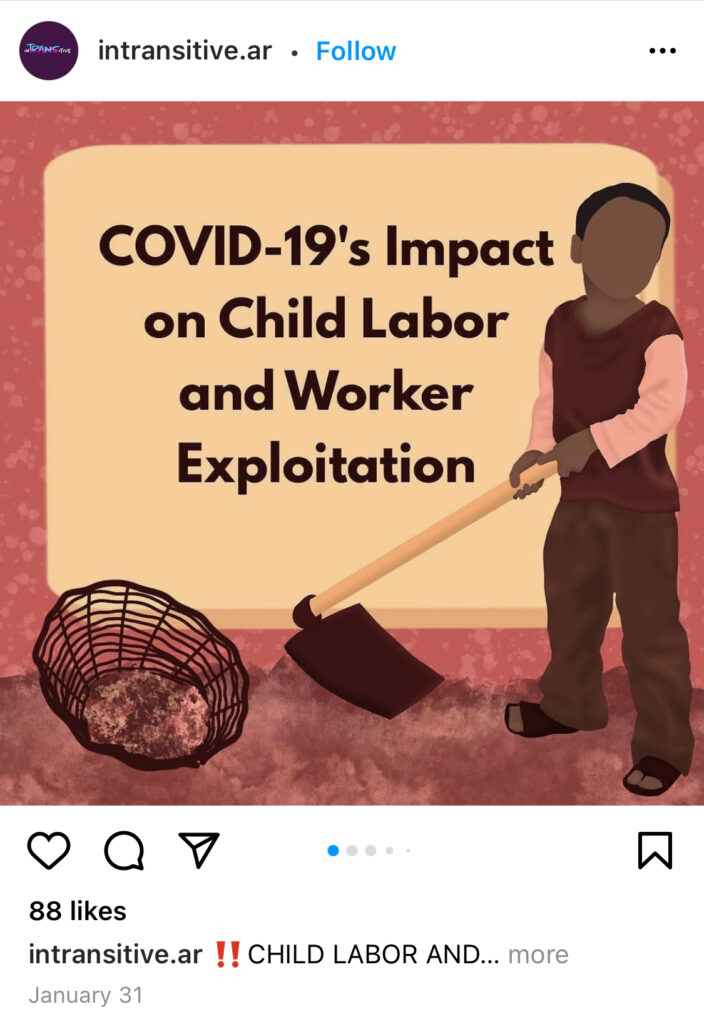
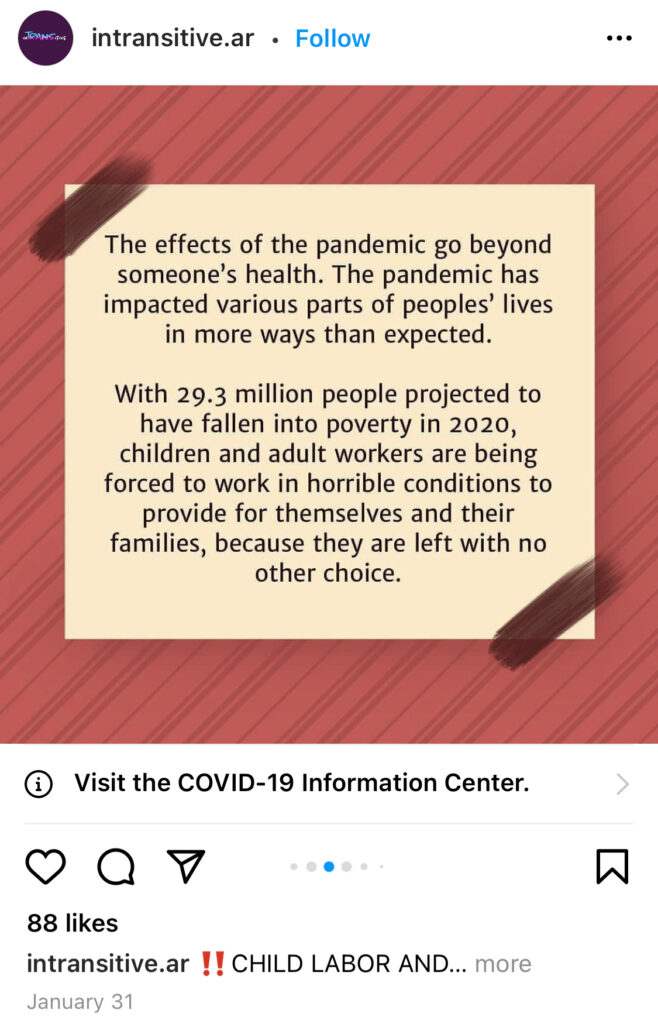
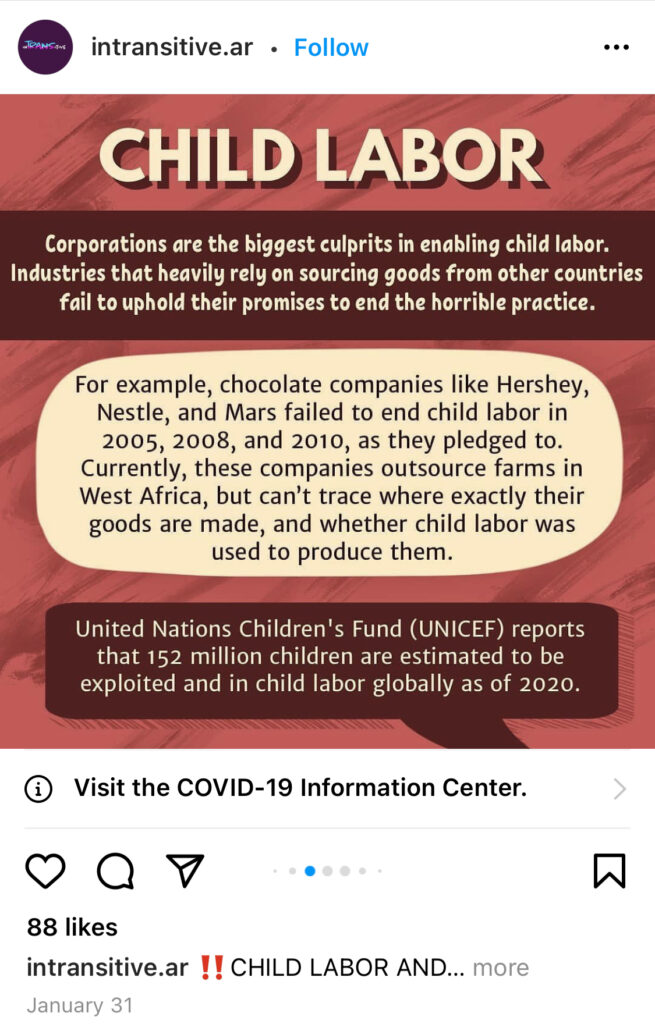
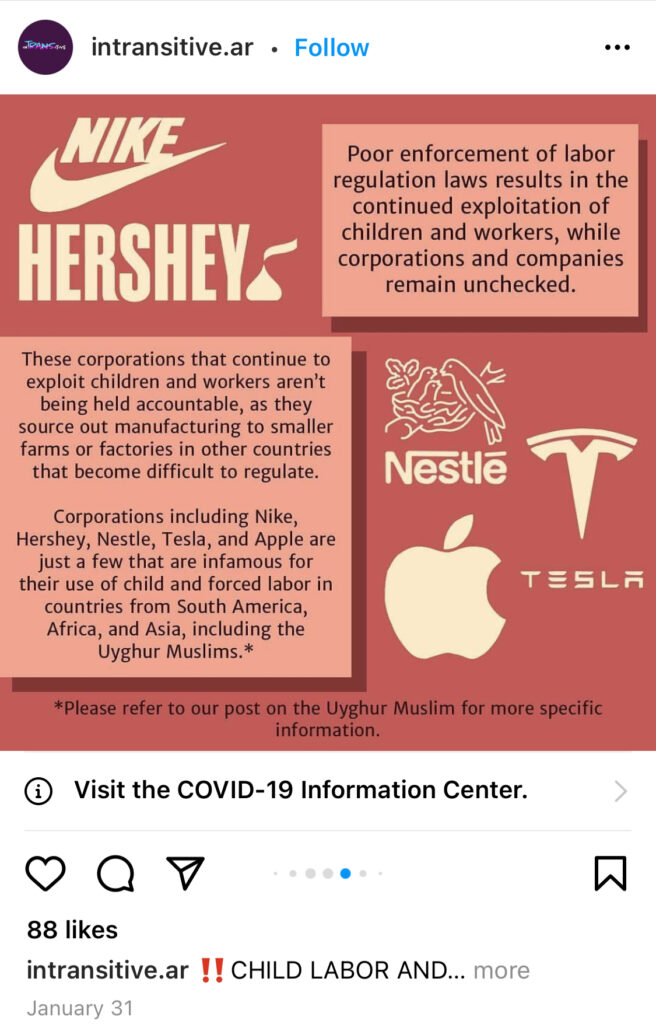
Here is a link to the full post:
https://www.instagram.com/p/CKtvyJNjnpl/?utm_source=ig_web_copy_link




Here is a link to the full post:
https://www.instagram.com/p/CKtvyJNjnpl/?utm_source=ig_web_copy_link

Question 1: How do systems of privilege and oppression function in our society? How do we combat these systems?
Systems of privilege and oppression function due to an unwillingness of those with power to make any concessions to allow for a society that uplifts all of its participants and allows them to flourish. Those with the most privilege are by nature the least aware of it. One way to combat these systems is by those with power and privilege stepping aside and giving up their place at the table to allow someone else a seat. This can include listening to and reflecting on the experiences of marginalized people without questioning the validity of those experiences. This can also include donating money to larger organizations that benefit marginalized groups. Being an ally also means calling out the hate speech of others, especially when no one else is around to see you do it.
Question 2: What is the concept of intersectionality and why is it important in women’s, gender, and sexuality studies?
Intersectionality is the concept that systems of oppression are intrinsically linked and therefore must be dealt with holistically. For example, it is not a sensible or intersectional approach to combat sexism while ignoring racism, and vice versa. Modern feminism prides itself on taking intersectionality into consideration in a way that previous waves of feminism hadn’t. The Riot Grrrl movement which occurred as part of third wave feminism was criticized as catering to white women and being exclusive of trans people. First and second wave white feminism has been criticized as only being focused on the rights of white women while ignoring racism and falling short as allies to women of color. Intersectional feminism recognizes that to ignore issues of race is racist, and there can be no justice without justice for all.
Question 3: Why is it important to recognize patriarchy as a system and not an individual identity?
Systems are made up of many parts which reinforce one another. There is no one person to blame for the patriarchy. Understanding that patriarchy is a system allows us to examine our roles within the system. Through examining these roles we can begin to question how we are complicit in the patriarchy. Examination helps us to choose actions which dismantle the system rather than reinforce it. Focusing too heavily on individuals who represent worst of the patriarchy detracts from the relationships we have with those around us that we are actually able to influence. Oftentimes this means family who disagree with us. We have a better chance of reaching them than someone they have no emotional attachment to.
Question 4: How is gender constructed and learned in our society? How do we perform gender?
Before we are even born, the expectations of our assigned gender are placed upon us. Sometimes this is blatant as with a gender reveal party. Sometimes this is more insidious as brothers and sisters are socialized and treated differently by the same set of parents. From a young age, girls are encouraged to conform through playing with dolls and pink toys, and boys by playing with action figures and cars. We perform gender through conforming to behaviors that are seen as the most socially acceptable for our gender. For men, this may mean holding the door for women. For women, this may mean not leaving the house without makeup on.
Question 5: What is the difference between sex and gender? How are sex and gender conflated (converged and confused) within our culture?
Sex is the sexual organs that we are born with. Gender is a social construct. Sex and gender are often used interchangeably and seen as package deals. In reality, a person with a penis can identify as female, a person with a vagina can identify as male, and a person with something in between can identify as somewhere in between, and all of the aforementioned combos can be scrambled interchangeably to produce innumerable amounts of gender identities that are as unique as the people who they belong to. Traditionally, non-typical sex and gender identities have been seen as strange, improper, and unacceptable by mainstream society.
Question 6: What is a double bind? How do double binds function within our society?
A double bind is when a marginalized person’s actions will be criticized no matter which path they choose to take. An oppressive society paints people into corners, only allowing them to be one thing or the other. Either way they are doomed to fail. An example of this is women being criticized for showing “too much” skin but also being criticized for not showing enough. By showing too much skin, women are derided as sluts or “asking for it”. By covering up or dressing more conservatively they are seen as prude or stuck up. Ultimately, marginalized people are subjected to double binds due to the contempt of the greater cisgender white patriarchal society.
The power and influence of social media in present-day activism cannot be understated. Almost everyone uses it, but few speak of it fondly. While the negative effects of social media shouldn’t be ignored, I believe that social media as a tool for social change is invaluable. As Wendy Syfret discusses in their book, “How to Think Like an Activist”, the ability of the Black Lives Matter movement to explode worldwide was due in large part to social media. This began with videos being shared showing the murder of young black men and boys including Trayvon Martin, who was just seventeen when he was murdered, Eric Garner and Michael Brown. (Syfret, 31).
A new breaking point was reached in May of 2020 with yet another unarmed black man, George Floyd, being murdered by Minneapolis police. As pictured in this week’s snapshot by Sanae Butler, protests and demonstrations spread like wildfire first throughout the U.S. and later across the globe. The ability for any person to go online and instantly learn the details of when and where the next protest was going to be, along with an outpouring of sharing on social media allowed support for the movement to multiply rapidly.
Of course, social media isn’t the only way for activists to raise awareness about an issue, as proven in the film “Girl Connected”, directed by Koen Suidgeest. The film follows five young women activists from various countries, displaying their motivations and actions for their individual causes. Josi is a young woman from Peru who noticed that many of her peers were becoming pregnant at a young age, cutting them off from other opportunities and creating a difficult set of circumstances for a young person to bear. Josi takes to the streets with a group of her friends, all equipped with megaphones to rally their neighbors to the public park in order to give a seminar on the consequences of unsafe sex.
“Girl Connected” is hugely inspiring because it chronicles each of these individual’s unique forms of activism, demonstrating that a difference can be made in the lives of others even by those who have been traditionally viewed as powerless. The young women chronicled come from economically disadvantaged backgrounds and countries in which women’s rights have not caught up to where they are in places like the United States. Despite this, they persevere and succeed in empowering others. Ayesha, from India, was unable to continue her schooling when her teachers could not accommodate the seizures caused by her epilepsy. That didn’t stop her from carving a non-traditional path for herself through Karate. She competes nationally and internationally, and trains other women and girls in the art of self-defense.
“To maintain an action for months, years or even decades you need more than a Facebook group. You need the support and trust of a solid community of like-minded activists, which is why the most impactful actions pair digital activism with traditional, person-to-person methods,” (Syfret, 31). Social media creates, grows, and reinforces communities of activists in real life. Going forward, we must use all tools available to us to invoke change.
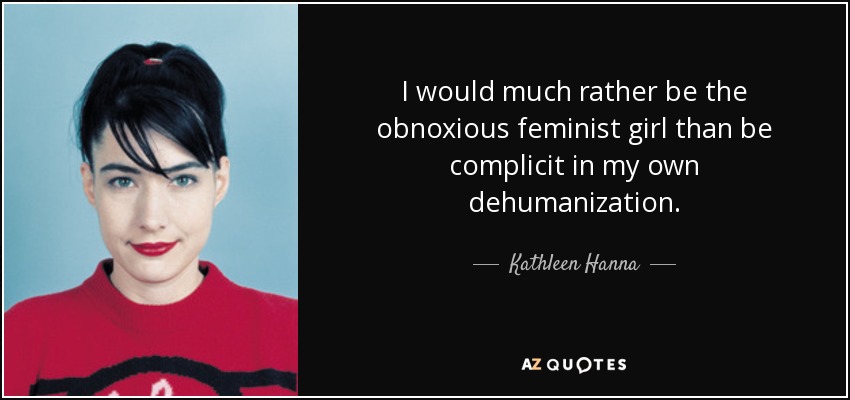
Allan G. Johnson’s “Patriarchy, the System” holds us all accountable for our actions by asking what kind of society would permit misogyny and crimes against women to take place. “We are involved in patriarchy and its consequences because we occupy social positions in it, which is all it takes,” writes Johnson. I really enjoyed reading this essay because it put the power to change the system in the hands of the individual without placing blame on them. Every time we choose to stay silent and maintain the status quo by taking the “path of least resistance”, we contribute to upholding the patriarchy or any other racist or homophobic beliefs.
If you’re not speaking up and speaking out against the side you disagree with, you might as well agree with them. Peer pressure and fear of being ostracized by one’s social group is a big deterrent against voicing an opinion that will rock the boat. When we recognize that what’s at stake is much larger than momentary social discomfort, the reasons to voice our opinions become all the more clear. Systems are comprised of individuals, not some nebulous “they”. Change begins with us.
“Above all, patriarchal culture is about the core value of control and domination in almost every area of human existence,” writes Johnson. In order to overcome the patriarchy, we must dissect its motivations. The desire to control and dominate is historical baggage. The need to colonize and enslave others stems from the same motivation. The patriarchy grows stronger by pitting oppressed groups against one another. In her book, “There Is No Hierarchy of Oppressions”, Audre Lorde wrote, “I cannot afford the luxury of fighting one form of oppression only. I cannot afford to believe that freedom from intolerance is the right of only one particular group”.
We cannot pick and choose which major forms of oppression are tolerable, because none of them are. Similarly, we cannot downplay the undertones of violence present in a seemingly harmless cat call because we think only what we perceive to be cold-blooded rape is a problem. This is the sort of thinking that leads to blaming women by asking questions such as, “What were you wearing?” or, “Were you drinking?”. In Ceranlly Serrano Rodriguez’s snapshot, they posted a picture of what appears to be a woman whose mouth is being covered up by the hands of others. Upon each arm a question is written which doubts the validity of the woman’s experience of rape.
It’s easier to silence marginalized groups than it is to listen and reflect. To choose to ignore another person’s experience is to uphold the status quo. The power truly lies with each of us as individuals. We must stick our necks out for others when we are able to do so especially when the threat of physical violence is not present. Failure to do so is effectively supporting the patriarchy. Reality is what we choose to make it. The only thing which must be silenced is hate itself. If we don’t silence hate, it will surely silence us.

Both “White Privilege: Unpacking the Invisible Knapsack”, by Peggy McIntosh and “Oppression”, by Marilyn Frye do a fantastic job of clarifying a couple of common misconceptions that white people have about white privilege and oppression. McIntosh writes, “I was taught to see racism only in individual acts of meanness, not in invisible systems conferring dominance on my group” (McIntosh, 1). Oftentimes white people engage in pointing the finger at one another by calling out the most heinous acts of racism, but fail to look inward themselves and recognize their own white privilege.
The fact of the matter is that white privilege is so insidious and all-encompassing that, much like life inside of the patriarchy, it can be difficult for white people to recognize what’s right in front of their face. When systems are skewed to benefit the majority, there is little to no motivation for those in power to sacrifice some their own power to benefit those who are systemically oppressed. Men will cling to power like life itself. It’s instinctual. It’s only when we start treating all people with respect and equality that we show any sense of true humanity.
Some people would rather live in denial then admit the error in their ways. There is a misconception amongst white people that the term “white privilege” denies the fact that white people experience suffering and hardship. This misunderstanding is illustrated perfectly by Kevin Kimble’s snapshot which states, “White privilege doesn’t mean your life hasn’t been hard; it means that your skin color isn’t one of the things making it harder”. Although the word privilege can feel like a loaded accusation because it’s associated with wealth, it doesn’t always have to do with money. According to the Oxford dictionary, the definition for the word “privilege” is “A special right, advantage, or immunity granted or available only to a particular person or group.”
It can be helpful to boil words down to their roots in order to dissect their meaning. Marilyn Frye does this with the word “oppression”. She points out that the root word “press” holds the key to understanding the difference between oppression and suffering. “Presses are used to mold things or flatten them or reduce them in bulk…Mold. Immobilize. Reduce” (Frye, 11). What she means is that a person who is oppressed is rendered powerless by forces so great that they have little if any chance of overpowering them.
The truth is that men suffer, and women are oppressed under the patriarchy. Men suffer under sexist beliefs that it’s not OK to cry or have interests that society deems to be “feminine”. Deep down we would all be better served to set aside our judgments of one another and give each other space to exist in all our forms and presentations. A less racist and oppressive world would benefit us all and open doors for everyone. There is nothing to be gained by continuing to oppress one another and everything to lose by not stepping up to the plate and taking ownership of the privileges that one was born with.
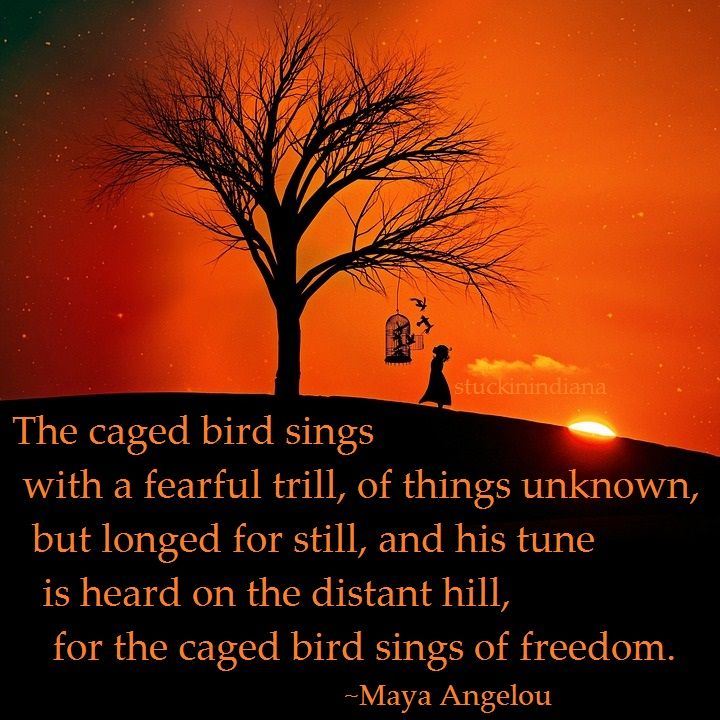
Alok V. Manon’s “Beyond the Gender Binary” gives the reader insight into what sorts of societal judgments and pressures that non-binary and trans people face daily. Something as simple as going to the grocery store can create intense anxiety for folks whose gender expression conflicts with the gender that they were assigned at birth. Manon writes, “The thing about being visibly gender non-conforming is that we are rarely if ever defended by other people in public. Everyone thinks that since we ‘made a choice’ to ‘look like that’, we are bringing it upon ourselves” (Manon, 12). The fact of the matter is that no one should have to defend their choice of pronouns. The way that a person dresses and expresses themselves should be up to them, and their pronouns should be respected.
Sadly, due to ignorance, a resistance to change, cultural or religious bias and fear some folks refuse to acknowledge the chosen pronouns of others. This is hugely invalidating for people who find their gender expression falling outside of societal norms. Consequentially, a refusal to call people by their preferred pronouns can contribute to worse mental health outcomes and even suicide. According to Manon, “40 percent of trans and gender non-conforming people have attempted suicide” (Manon, 10). Trans and nonbinary people are dehumanized daily.
In their snapshot, Sadira Mohammed writes that her little sister corrected a boy at school who was “having trouble understanding why one of their other friends has They/Them pronouns.” Sadira explained that “sexuality is about your mind and your soul it has nothing to do with this avatar we live in called the human body.” I thought this was a really great way of putting things. We must learn not to take people at their perceived face value so that we may see the world more clearly. It was also heartwarming to read that school-aged children are having these sorts of conversations at such a young age and even educating one another. This gives me hope for the world.
There is a tendency of some people to dismiss an experience that isn’t their own. This is true of racist and sexist beliefs as well as transphobic and homophobic beliefs. This is where the problem lies. I believe that you don’t have to understand exactly where people are coming from to empathize with and respect their situation. We should do our best to educate ourselves on the struggles of others so that others aren’t constantly burdened with educating us. However, empathy must be out default and in some cases, it must come before understanding.
It’s heartbreaking that trans and non-binary people are driven to suicide due to society’s disregard and disdain for their existence. When I was a kid, the saying, “Sticks and stones may break my bones, but words will never hurt me,” was a popular one. The truth is that words do hurt. Emotional pain is real pain. I believe that if more people understood the severity of the effects of misgendering others, they would do better. Religious beliefs shouldn’t prevent people from empathizing. The root of all religions is love, which trumps hate, always.